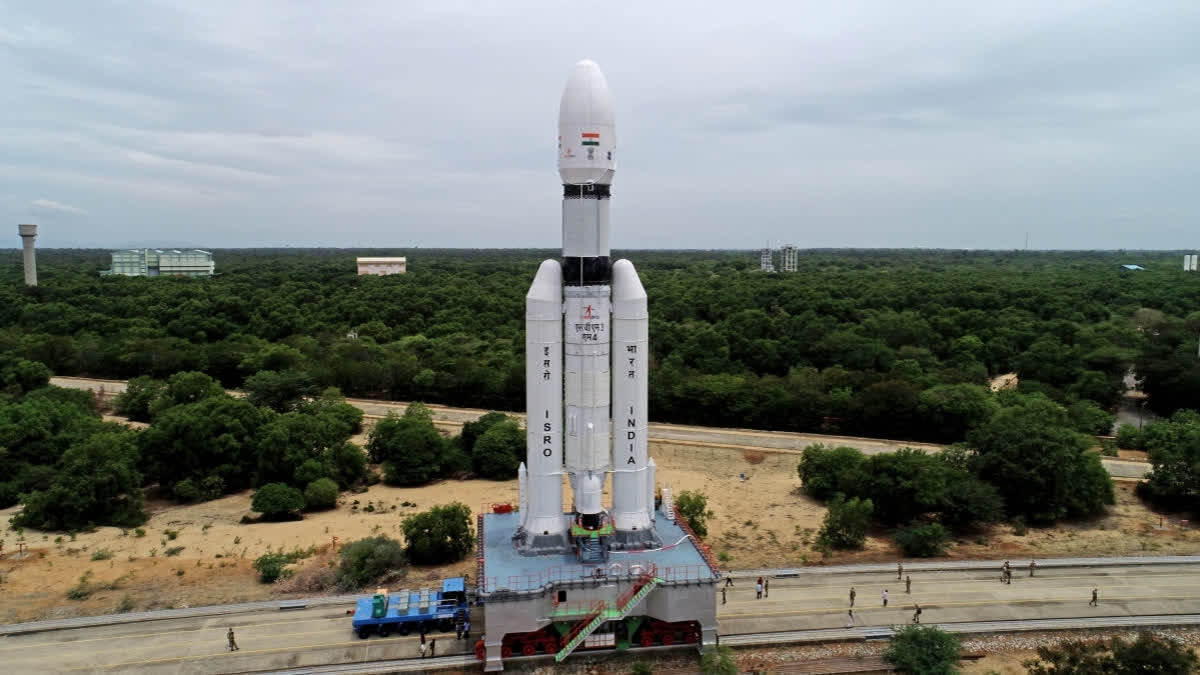Hyderabad: As the countdown begins for the launch of Chandrayaan-3 at 2:35 pm on Friday from Sriharikota in Andhra Pradesh, carrying the hopes of an entire nation. With the primary objective is to conduct a soft landing on the lunar surface and deploy a rover to explore the landing site. If ISRO pulls this mission off successfully, India will join an exclusive list of just three other nations the United States, Russia and China to have landed softly.
- The Indian Space Organisation (ISRO) is keenly monitoring the mission as Chandrayaan-3 is a follow-up mission of Chandrayaan-2 which failed to land softly on the moon.
- The lunar's Lander Vikram (named after Indian space program pioneer Vikram Sarabhai) having a mass of 1749.86 kg (including a 26 kg rover) is a box-shaped (200 x 200 x 116.6 cm), with four landing legs and four landing thrusters which can generate 738 W using side-mounted solar panels. The lander will be preached on a Launch Vehicle Mark 3 (LM-3), the GSLV standing at 43.5 meters. The journey is expected to take 40 days i.e. the lander carried by spacecraft is expected to make a soft landing on the moon on August 23 or 24.
- Primarily, to begin with, getting as far as the Moon is quite difficult. It is more than 384,400 kilometres away from our planet having an extremely thin atmosphere. This means that the spacecraft cannot rely on the atmospheric drag to slow them down to a reasonable speed before landing, which Chandrayaan-2's lander was not able to achieve resulting to crash into the surface of the moon.
- India's Chandrayaan-3 will be landing at the south pole of the lunar surface at 70 degrees latitude. Many polar regions like in complete darkness and temperatures can go below 230 degrees. As we can say they are “frozen in time” which will give the opportunity to explore the minerals and the presence of water molecules on the lunar surface. They are also typically littered with many craters.
- Vikram is meant to have a safe, soft landing. The lander will then release the Pragyan (Sanskrit for "wisdom") rover, which has a rectangular frame (91.7 x 75.0 x 39.7 cm) mounted on a six-wheel rocker-bogie wheel drive assembly. It has navigation cameras and a solar panel that can generate 50 W, will roam the moon's surface for a lunar day - equal to 14 earth days - and conduct scientific experiments.
- The ISRO scientists have equipped the lander to carry an instrument called Chandra’s Surface Thermophysical Experiment (ChaSTE) to measure surface thermal properties, the Instrument for Lunar Seismic Activity (ILSA) to measure seismicity around the landing site, the Radio Anatomy of Moon Bound Hypersensitive ionosphere and Atmosphere (RAMBHA) to study the gas and plasma environment, and a passive laser retro-reflector array provided by NASA for lunar ranging studies.
- Following the "failure-based design" strategy, ISRO aims to identify and address potential failure points early in the mission development process one of them being with five engines this lander has two engines to do the landing and the central engine being removed.
- The ability to handle the parameter dispersion of Chandrayaan-2's lander was very limited. Therefore, Somnath, head of ISRO said that they have designed the new mission based on the lessons learned from the previous ones, by considering thousands of possibilities about what can go wrong by evaluating several scenarios including sensor failure, engine failure, algorithm failure, and calculation failure and have developed measures to counteract them so that the lander will be ready to tackle them.
- The Chandrayaan, first launched on October 22, 2008, marked India as the fifth nation to put a vehicle in lunar orbit but the mission was officially deemed a failure by ISRO in 2009, after nearly a year of battling technical difficulties and a subsequent contact failure.
- India’s maiden lunar mission discovered water molecules on the moon’s surface. Eleven years later, the Chandrayaan-2 successfully entered lunar orbit but its rover crash-landed on the moon’s surface. It too was supposed to explore the moon’s South Pole. Although the orbiter still circles the moon and is sending data.
Also read: Timeline of Chandrayaan missions undertaken by ISRO



